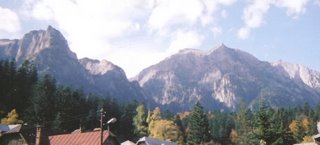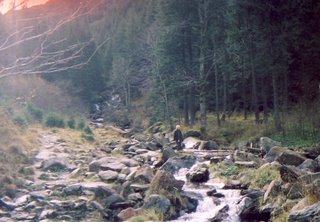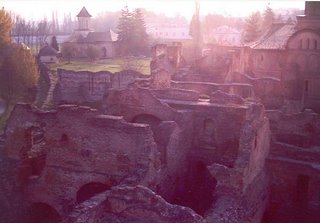Transfagarasan Pass
Carpathian Mountains
 Carpathian Mountains, Transfagarasan Pass, Romania
Carpathian Mountains, Transfagarasan Pass, Romania1. Blasting open the Pass
The Fagaras Mountains, are part of the Carpathian Range. Wallachia is on one side (Vlad was Wallachian) and Transylvania on the other.
There is a history of hardship and labor deaths here, from blasting a way across and through a tunnel, for vehicles. See http://www.expeditionplus.com/2006/07/the_fagaras_mountains_and_the_1.
The Pass was built as a way to move troops and ammunition to defend against a feared Soviet invasion, 1968. The Transfagarasan Pass, through and over the Transfagarasan Mountains, is more easily remembered by the name of the town at the north side, Fagaras. See http://www.transylvania-discovery-tours.ro/en/top/daily-tours-in-transylvania/land-of-fagaras-day-tour/
2. Accessibility
The Pass in these mountains is open as weather and season permit.
There is a sign at a town in the southern end of the road, at Curtea de Arges, that will give the information, we now hear.
We didn't know that, but went up anyway with the intention of using common sense, and turning back if the road was closed. This was the end of October - lovely for leaves, not quite New England, but fine. The fine weather below can be misleading. Again, before going toward the Tranfagarasan Pass, check that the entire road north is open through the Carpathians. It closes seasonally, and depending on the weather. The gap on maps signifies tunnels, against rock slides and snow.
3. Accommodations
Cabanas is the magic word. There are hotel-type places for sleeping, called Cabanas. Are they government-run? Not sure. Just don't let it get dark on you. Stop in time. For an overview of the mountains in Romania, see "Romania's Road to Heaven," at http://www.escapeartist.com/efam/68/Living_In_Romania.
On the way, we knew there would be "cabanas" or small hotels, but did not expect the distances between. Don't wait too long in the day to stop. You need all the visibility you can get - not all vehicles have good headlights, and animals may wander in the road. We were just about to turn back, when one appeared. Do not expect signs to tell you when the next will emerge.
At the northern end of the pass are Sighisoara, the birthplace of Vlad III Tepes, and Sibiu; entry to the painted monastery areas, and much more. See Romania Road Ways.
 Transfagarasan Pass, midday hike, Romania
Transfagarasan Pass, midday hike, RomaniaStart early the next day. There are hairpin turns, incredible cliffs and a winding road.
We took our time the next day. Stop along the way and take a hike. If you are a worrier about leaving the car, you will miss out. We never had a problem. How long will that last? There is the Car half of the Car-Dan Tour Company, snapped by the Dan, crossing a boulder-strewn creek bed with no particular destination in mind.
Then, in the distance and above, is the Vlad Tepes castle, where he sought to defend against the invading Ottomans.
This site does not name Poinari Citadel, however; but tells the story as he escapes to another castle at Targoviste. See http://www.davidstuff.com/historical/vlad.htm; and the more touristy http://www.romaniatourism.com/dracula-legend.html
 Vlad Tepes castle ruin, Poinari Citadel, Transfagarasan Pass, Romania
Vlad Tepes castle ruin, Poinari Citadel, Transfagarasan Pass, RomaniaThe castle ruin is to the left, on the mountaintop.
This Carpathian area is historically central to any trip to Romania, whether focusing on Vlad or not. His actual castle up here, one of them, is a fine attraction, but there is much else to see. See http://www.expeditionplus.com/2006/07/the_fagaras_mountains_and_the_1.
More blogs about Romania Road Ways Vlad Tepes - Impaler.
 Dan Widing, Poenari Citadel path, Castle, Vlad Tepes, Romania
Dan Widing, Poenari Citadel path, Castle, Vlad Tepes, Romania Poinari Castle, there at the peak, Transylvania, Romania
Poinari Castle, there at the peak, Transylvania, Romania  View from Poenari Citadel, Castle ruin, Vlad Tepes, Romania
View from Poenari Citadel, Castle ruin, Vlad Tepes, Romania Poinari Citadel, Transfagarasan Pass, Romania, view down
Poinari Citadel, Transfagarasan Pass, Romania, view down Dan Widing with guide at Vlad's castle ruin, Poinari Citadel, Romania. Note driving cap.
Dan Widing with guide at Vlad's castle ruin, Poinari Citadel, Romania. Note driving cap. 
 Hotel Castel Dracula, near Bistrita, Romania
Hotel Castel Dracula, near Bistrita, Romania Dan Widing locates The Coffin, Hotel Castel Dracula, Romania
Dan Widing locates The Coffin, Hotel Castel Dracula, Romania



 The Dracula Club, Bucharest, Romania
The Dracula Club, Bucharest, Romania Dan Widing welcomed at the Dracula Club, Bucharest, Romania (on Halloween)
Dan Widing welcomed at the Dracula Club, Bucharest, Romania (on Halloween)